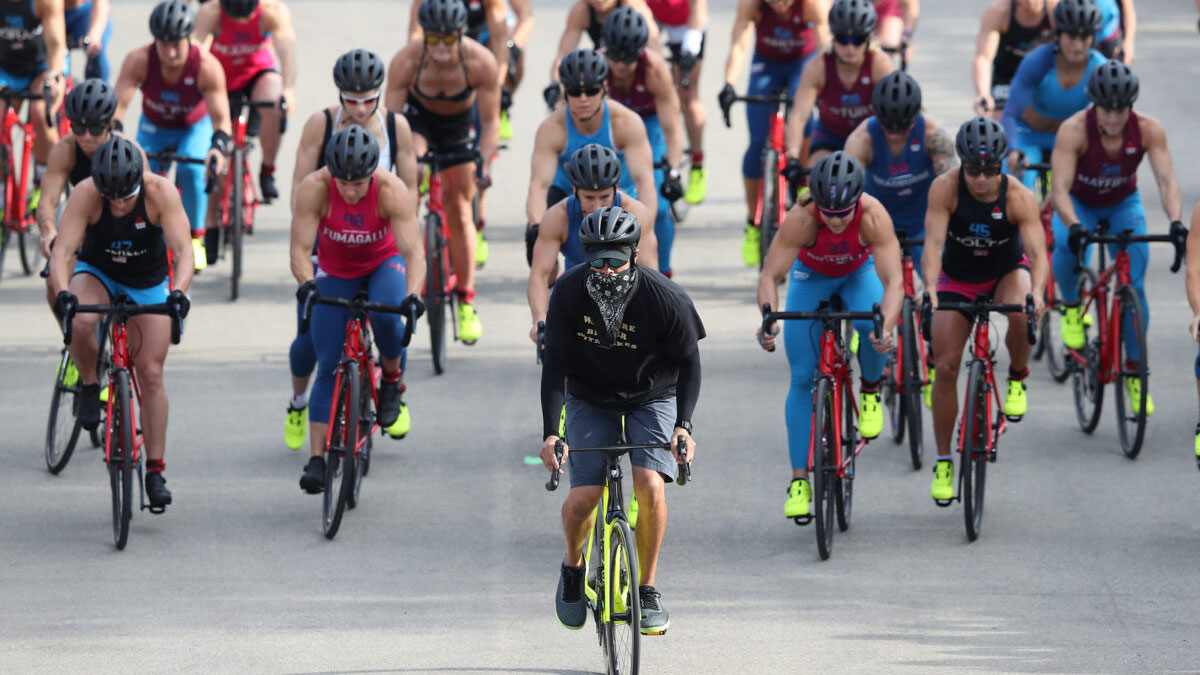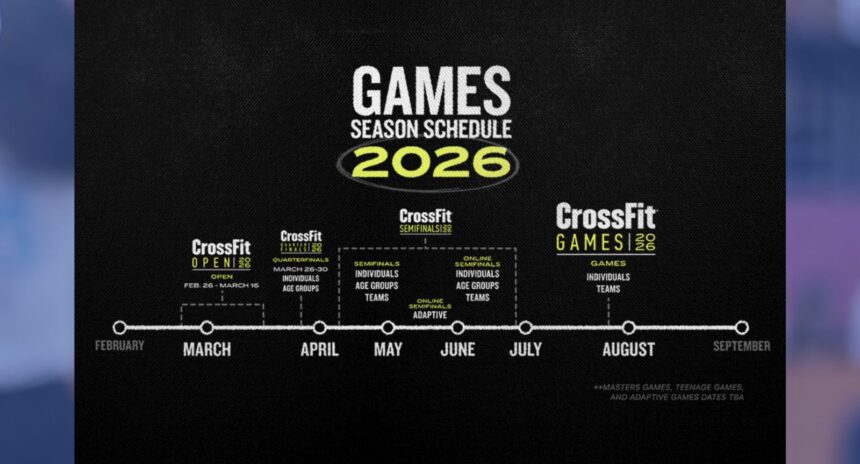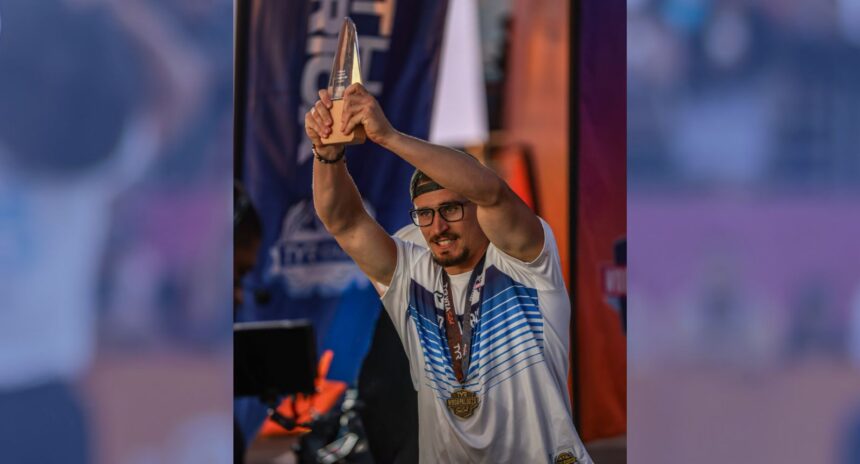Dave Castro’s Programming Legacy: The CrossFit Games

Finally, we reach the pinnacle event, and the pinnacle of Dave Castro’s programming; the final stage of each competitive season since 2007: the CrossFit Games. However, if you haven’t read the previous two pieces about the Open and Regionals we encourage you to go back and do so, many implements from the Games have borrowed from the qualifying stages, and many elements of the Games have similarly found themselves in earlier stages of the competition a few years down the road. So for the most comprehensive understanding of the genius and continuity of Castro’s programming legacy, go check those out and we’ll see you back here shortly.
- Dave Castro’s Programming Legacy, Part 1: The Open
- Dave Castro’s Programming Legacy, Part 2: Regionals
The Unknown and Unknowable
Is there really any place to start but here? These four words are synonymous with the CrossFit Games, especially for those that were around when it all began, at Dave Castro’s Ranch in Aromas California in the summer of 2007 with the second CrossFit Games workout of all time: The Hopper.
This workout, and this concept are so important and iconic for both the sport and the methodology of CrossFit. And, as we’ve been discussing, Castro has managed to maintain the integrity of baseline CrossFit principles even as the sport has exploded in the 15 years since.
This content is available exclusively to Members
Become an member and start enjoying full access to all our community and sports content, and an ad-free experience.
- Exclusive content
- Ad-Free web/app experience
- Comments on articles
- Exclusive 15% WIT discount
- $1 per month for the first 4 months, $8 each month after
- Exclusive content
- Ad-Free web/app experience
- Comments on articles
- Exclusive private Facebook Group
- Regular coffee breaks hang outs
- Exclusive 15% WIT discount
billed annually
Already a member? Log In.
In the Level 1 manuscript exists the Hopper Model, a principle that must be understood to comprehend “fitness”: “a hopper is loaded with as many different skills and drills imaginable…do not exclude anything: the more, the better… Here is the contention: he or she who performs best at these randomly assigned physical tasks is the fittest.”
In 2007, this was done in creating the second of three tests for the first-ever CrossFit Games:
A 1000 meter row, followed by 5 rounds of 25-pull-ups and 7 push jerks at 135/85 lbs.
The concept of “Unknown and Unknowable” became a fixture amongst the Games team, but also in the programming. It would never take on exactly the same structure as that original Hopper workout, but the implication has been there so many times since…
“This is the CrossFit Games”
One of the ways Castro would continue to include elements of surprise and intrigue is with this simple saying. Over the years he would periodically introduce workouts shortly before athletes started them. And in his classic and unique style, he’d conveniently leave something out, give the athletes and fans a chance to digest what he’d just explained, and then continue…
With the phrase, “this is the CrossFit Games” (or something comparable) he would then smile that famous Dave Castro smile and add something to the workout.
- The End 1,2,3 in 2011
- Double Grace in 2014
- Marathon Row in 2018
- The freestanding handstand push-up in 2021
The nuance of providing the athletes with some, but not all of the information, is something competition directors and programmers have continued to implement at competitions of all kinds. Add it to the list of ways Castro has influenced not just programming, but the presentation of it in more recent years.
Off-Site Workouts
One of the most obvious differences between the Games and all competitions leading up to it is the ability to increase the scope of the test in terms of space. However, throughout the years Castro took this concept far beyond what most other programmers would have dared to try.
The first “off-site” workout is arguably the trail run on his ranch in the inaugural competition in 2007. The inclusion of this single modality, monostructural test as one of only three tests at the first Games signifies the importance of the ability to test athletes in environments they have little to no hope of preparing for ahead of time.
In particular, the evolution of these workouts are amongst the most noteworthy in the history of the Games:
- 2009 saw the return of the trail run, but also added the infamous Hill Sprint with sandbags event (one of the most painful events in Games history according to many of the athletes who were there)
- 2011 – The Beach: not only was this the first swimming workout in Games history, the entire workout took place at the Santa Monica Pier and featured open water swimming, long-distance running in sand, and even a rig on the beach which was set up specifically for this workout.
- 2012 – Pendleton 1 & 2 (and the often overlooked Obstacle Course) was a major surprise for anyone who wasn’t in the know as athletes had the opportunity to complete the first three events of that year’s test at Camp Pendleton, _____ miles away from Carson, California where the remainder of the competition would be.
- 2016 – Return to the Ranch. Not only had the CrossFit Games grown in popularity by this time, the lore of the original CrossFit Games location, the Ranch in Aromas, had become a thing of legend for most. In this final year of competition in California, however, that lucky group of Games athletes got perhaps the biggest, and best, surprise any group of Games athletes has ever been gifted by Castro- the opportunity to return to the place it all began for the first three workouts that year.
- 2017-2019 and 2021 – these four years the Games were hosted in Madison, WI, and in each iteration of them Castro kept the tenant of including an off-site style event part of the programming:
- 2017: Run Swim Run (event 1)
- 2018: Crit (event 1) and Madison Triplus (8)
- 2019: Swim Paddle (Event 9)
- 2021: Event 1 (swim with fins, kayak)
- 2020 – For what will now almost certainly be the final time, an exclusive group of 5 men and 5 women got to compete one last time at the Ranch. Castro brought back concepts from 2007-2009 as athletes got to tackle the Ranch Loop, the Corn Sack Sprint, and Happy Star all of which featured aspects of the famous dusty hills in Aromas.
A New Twist on an Old Movement
Studying the evolution of movements that have been included at the CrossFit Games specifically over the years reveals something akin to the evolution of Pokemon. You get the basic movement one year, and at some point in the future, you get its evolved form. Here are just a few examples of this over the years from the Games:
| Original Movement | Year | Upgraded Movement | year |
| handstand push ups* | 2008 | ring hspus | 2010 |
| handstand push ups | 2008 | free standing hspus | 2021 |
| overhead walking lunge with a plate | 2009 | overhead walking lunge with a barbell | 2013 |
| Rope Climbs | 2010 | Legless Rope Climbs | 2013 |
| Pistols | 2010 | Weighted Pistols | 2013 |
| Toes to Bar | 2009 | Toes to Ring | 2019 |
| Split Snatch | 2012 | DB Hang Split Snatch | 2019 |
| handstand walking | 2013 | wall walks** | 2021 |
*Note: there have been several iterations of handstand push-ups over the years, the ring and freestanding handstand push-ups variations stand out as being very unique to the Games however
**This is arguably the only one on the list in which the level of difficulty is actually less than its predecessor
Make no mistake about it, Castro was very aware of this and undoubtedly spent countless hours studying where the Games had been to envision where it would go next; and though we cannot confirm it, in some cases it really feels like he had the later evolution in mind, but remained patient, programming it’s basic forms first (sometimes even many times) before ramping up the difficulty or complexity.
One and Done Implements
Almost in direct contrast to the concept of movement evolutions at the Games; Castro also has included implements periodically over the last 15 years which have shown up once, and then never been seen again. They are few and far between, but this is another wrinkle of the diabolical nature of his programming because once these things show up, athletes take note and will try to prepare for them…but sometimes all that preparation is for nothing as they never show up again.
| One Time Use Movement of Implement | Year |
| Pound a Stake into the Ground | 2009 |
| Overhead walking Plate Lunge | 2009 |
| Dog Sled | 2011 |
| L-Sit | 2011 |
| Softball Throw | 2011 |
| Sumo Deadlift High Pull (KB) | 2011 |
| Broad Jump | 2012 |
| GHD Med Ball Toss | 2012 |
| Burpee Muscle Up | 2012 |
| Iditarod Drag (Burden Run) | 2013 |
| Weighted Pistol (Cinco 1) | 2013 |
| Kettlebell Thrusters (the Beach) | 2014 |
| Dumbbell Squat Snatch (PTTM 1) | 2015 |
| Snail Push | 2016 |
| Rescue Randy Drag (Battleground) | 2018 |
| Kettlebell Jerks (Second Cut) | 2019 |
| Toes to Ring | 2019 |
| Ball Slams | 2020 |
| Kayak | 2021 |
| Wall Walks | 2021 |
| Single Arm DB Overhead Squats | 2021 |
| Freestanding handstand push-ups | 2021 |
A couple of important notes here:
- Some of these things were likely never repeated because the repeatability of them wasn’t necessarily logical (pounding a stake into the ground for example)
- The “skills” tests from 2011 and 2012 stand out for many as an example of programming gone wrong; but if you defer back to the Hopper model, the more that is included the better. Could we see the return of skills testing moving forward as a potential new programmer borrows from Castro’s past?
- With the implementation of 4 new and unique movements to the CrossFit Games repertoire in the 2021, all signs indicate that Castro was not near the end of his programming rope. Despite having done this for so long, he was still coming up with new challenges for the athletes leaving one to wonder what would have been next (in the years to come) if he had not been fired.
Saturday Night Live
It would be implausible, nay, irresponsible at best to dive into the programming exploits over the years and not give a nod to the yearly must-watch event that is the final event on Saturday evening of the Games. So much of the Games lore in the early days is tied to the “light of the tennis stadium,” during the era of the Games in Carson, California, but as part of Castro’s yearly research, he spends time walking the venue, envisioning the environment, and as a result has been able to carry the magic of the moment over to Madison.
The events have helped solidify some athlete’s legend in the minds of the community, while also serving as springboards for their initial stardom. Included with each event, we’ve also listed the individual winners of each because it doesn’t hurt to walk down memory lane.
- 2010: Sandbag Move – Annie Thorisdottir, Tommy Hackenbruck
- 2011: Killer Kage – Elisabeth Akinwale, Spencer Hendel
- 2012: Chipper – Rich Froning, Julie Foucher
- 2013: 2007 – Josh Bridges, Valerie Voboril
- 2014: Push Pull – Josh Bridges, Michele Letendre
- 2015: Triangle Couplet – Mat Fraser, Camille Leblanc-Bazinet
- 2016: 100% – Alessandra Pichelli, Brent Fikowski
- 2017: Heavy 17.5 – Kara Saunders, Mat Fraser
- 2018: Bicouplet 1 & 2 – Willy Georges, Rasmus Anderson, Kara Saunders, Camille Leblanc-Bazinet
- 2019: Clean – Mat Fraser, Tia-Clair Toomey
- 2021: Snatch – Tia-Clair Toomey, Gui Malheiros
It is no mistake that the list is chock full of certified legends of the sport, and in almost every instance, their performance helped catapult them to a strong finish, or announced their arrival to the community.
It also helps that in the grand scheme of the competition, there is always a sense of urgency that builds throughout the day, crescendoing in the evening as athletes make a final push on “moving day,” to try and position themselves favorably on the leaderboard for Sunday.
How Strength Is Tested Part Three
The final installment covering the impact of the various strength tests throughout the season is without a doubt the most important. Strength tests at the Games have consistently set the high water mark for performance, entertainment, and creativity. Some variations have presented themselves prior to the Games at non-sanctioned competition (spotlight lift), but their use at the Games took it to another level.
- Lifting Ladders: 2009 Deadlift, 2012 Clean Ladder, 2013 Clean & Jerk*, 2016 Ranch Deadlift
- Speed Ladders: 2014 Clean Speed Ladder, 2015 Snatch Speed Ladder, 2018 Clean and Jerk Speed Ladder
- Platform Progression: 2014 Overhead Squat, 2015 Clean and Jerk, 2017 1RM Snatch, 2018 CrossFit Total,
- Couplet Ladders: 2017 Muscle Up Clean Ladder, 2021 “Event 8 and 9” Run and Clean,
- Spotlight Lift: 2019 Clean, 2021 “Event 12” Snatch,
*Note: Slight variation, athletes got to pick designated starting weight before progressing through the set barbells in the ladder.
The ripple effect that occurs can be seen in the replication of formats, and scenarios at various in-season and off-season events that were first implemented at the Games. In many cases, we’ve seen formats used multiple times before being tweaked or left in the rear view altogether, but the impact is forever cemented by their inclusion at the top of the sport.
Finishing With A Bang
Programming the deciding event of the CrossFit Games is a difficult task, there’s no guarantee that in the era of dominant champions that the points spread and podium races will be such that the finale isn’t just a victory lap. But well before we saw multiple CrossFit Games titles in the hands of a select few, it was clear that Castro had visions for finales that – irrespective of points and races – could leave the competition on a high note and finish the weekend off with some fireworks.
- 2008: Heavy Squat Clean Grace. Jason Khalipa comes from out of nowhere to win the title and shock everyone.
- 2009: Chipper. Annie Thorisdottir misses the podium, but gets her first muscle up.
- 2010: The Final 3. Graham Holmberg wins after Rich Froning falls from the rope. Chris Spealler wins to secure a podium spot.
- 2013: Cinco 1 and 2. Live on ESPN, Rich Froning goes back to back, winning both events to take home his third straight title.
- 2014: Double Grace. Froning wins every event on Sunday, including Double Grace to seal his fourth title.
- 2015: Pedal To The Medal 2. Katrin Davidsdottir and Ben Smith put the finishing touches on title runs that for many seemed improbable at points throughout the weekend.
- 2016: Redemption. With a seventh 2nd place finish of the weekend, Mat Fraser ushers in a new era of men’s competition in dominant fashion.
- 2017: Fibonacci Final. The most electric finish in CrossFit Games history between Tia-Clair Toomey and Kara Saunders. When the dust settles, only 2 points separated them overall. (Do yourself a favor and rewatch that clip).
- 2019: The Standard. Mat Fraser battles back and snatches the title away from Noah Ohlsen after a weekend full of drama.
- 2020: Atalanta. Hand in hand, Fraser and Toomey cross the finish to make history together. Kari Pearce makes her podium dreams come true with an epic performance.
- 2021: “Event 15.” After a week-long battle with Pat Vellner and Brent Fikowski, Justin Medeiros wins his only event of the weekend to secure his first CrossFit Games title.
Personal tastes on programming aside, it is significant that many of the lasting memories and pictures surrounding each finale don’t always include the winner. It’s also important to remember that sometimes giving the athletes the platform and opportunity to shine is a programming skill in and of itself. Given how many times we’ve seen a heat of athletes rally behind the last to finish, one could say it is quite on brand for the CrossFit Games.
Editor’s Note: We hope you enjoyed this three-part series on the programming legacy of Dave Castro. As the sport enters a new era, one that will undoubtedly be filled with the same inspiring performances that characterized the first 15 years, it was important to us to reflect on the foundational elements that helped solidify the sport’s current status. Good luck in the 2022 CrossFit Open!

